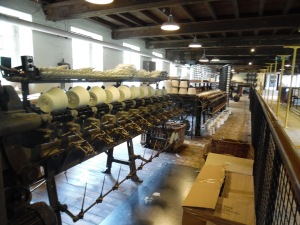
Up until the Industrial Revolution wealth was generated through land ownership and tenants. The aristocracy had first dabs on most of this due to their titles and rights of inheritance, even lesser landlords could generate sufficient income to keep buying and selling property. Country houses and grand estates are dotted up and down the country as a legacy of this feudalism.
In the late 18th century, a new class of wealth, rather like the Medieval merchants of the small towns and cities, rose due to the latest innovations in ironwork and steam engines. In the north of England, the textile industry boomed as machinery replaced hand looms. The weavers no longer worked in their own homes but were drawn to the bigger cities to work in factories.
Quarry Bank Mill is one such place that grew and grew.
Samuel Greg, born in Ireland (1758) to a wealthy merchant was adopted by his uncle Robert Hyde and was sent away to be educated. He impressed his uncle and was made a partner, then when Robert died, he inherited all of his property. Samuel had a vision – the cotton spinning industry – and he chose a suitable location for his mill (water power was crucial for running the machines until steam engines took off) on the banks of a river near Manchester. He married Hannah Lightfoot and acquired her dowry to further invest in his business. The couple moved out of the dirty streets of Manchester and built Quarry Bank House right next to their mill.

Samuel built cottages for his workers and an apprentice house for his child labourers. It was a long time before laws banning children in mills came into force. By the time of the Napoleonic Wars he’d acquired other mills and 2000 employees.

Styal workers cottages

Dormitory in Apprentice House (beds were shared)
However, Samuel wasn’t as progressive as his sons. He resisted bringing in looms to weave the cotton and retired in 1832 after becoming lame due to an accident. At the time, his business was the largest spinning industry in England. His son introduced weaving and the massive looms.
Working conditions in the mills were tough:
High temperatures, humidity and the windows kept shut – the inhalation of cotton dust led to incurable lung diseases.
Fingers and limbs were lost in the machinery, usually in the last two hours of the working day when the workers were tired – they worked from six in the morning to eight at night with one lunch break. Robert Greg opposed the introduction of the 10 hour working day on the grounds it would reduce production and bring in foreign competition.
Cancer of the groin was common, because the workers leaned into the oiled parts of the machine – oil is carcinogenic. Also cancer of the mouth, from the ‘kissing shuttle’ – sucking the cotton through the shuttle.

The Gregs employed a doctor to oversee the health of the children, and their morals too. They appreciated that treating workers fairly increased productivity, but by modern standards, it does seem far too little. Why did these kids work in the mill? Because it was a better life than the workhouse.

The family lived in Quarry Bank Mill House with a view of their terraces gardens, while remaining a short walking distance to their mills. A haven for the owners, who could escape the noise and bedlam of both factory and city. The house and mill now are in the care of the National Trust and they have carefully reproduced both the authentic interior of the house and the working machines in the mill.
“Beautifully written mystery weaves a spell around the house and the people connected to it.” Goodreads reviewer
Pre-order The Women of Heachley Hall – release date 4 May.
Sign up to Rachel’s Readers for the First Chapter of The Women of Heachley Hall










I can’t imagine sharing one of those beds! Interesting post.
LikeLike
Better a bed then the floor! It’s hard to imagine the life they led.
LikeLiked by 1 person
A difficult transition for humanity but necessary. Interesting post.
LikeLike
Looking back on those times, it’s hard not to judge these industrialists harshly.
Thanks for stopping by.
LikeLike
We are certainly fortunate to live in better times than then. This would be an interesting place to visit.Facing Cancer with Grace
LikeLike
A challenging time with slavery and child labour carrying the Industrial Revolution forward.
thanks for stopping by.
LikeLike
I love visiting Styal Mill
LikeLike
We love visiting too. Always lots to see – and I didn’t even touch on the huge water wheels and steam engines.
LikeLiked by 1 person
“…apprentice house for his child labourers.”
Sigh.
LikeLike
There were no laws preventing the use of children in factories until mid-1800s. The apprentice house would have been considerable better than the workhouse, which was effectively a prison for the poor.
LikeLike
[…] Q: Quiet Writer, Quarry Bank Mill House (there was only one Q blog in the challenge. good thing they st… […]
LikeLike